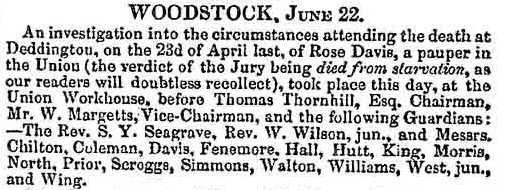Millennium Project
By Jon Malings
Rose Creek was baptised on November 30th 1788 in Deddington. She was the only child of Thomas Creek of Lower Heyford and Ann Rose. The couple were married at St. Peter in the East, Oxford, in 1787.
Thomas Creek must have died sometime before 1793 as Rose’s mother Ann then married Thomas Malins in Deddington on January 15th of that year. The couple had 6 children including William (1794) and Robert (1801) who were half-brothers and sisters for Rose.
Rose married Thomas Davis, a labourer, in Deddington in 1820, her half-brother William Malins was witness. Of Rose and Thomas’ three children only one, Ann, survived to marry. Their daughter Mary died of consumption aged 14 and their son David died aged 14 months. Thomas Davis himself died in 1836 aged 46.
Rose appears on the 1841 census living with her daughter Ann in Pilcock Street, Deddington, no occupation is given for either. It seemed census takers could name streets to their own taste. What was/is Philcot street in 1808, 1861, 1871 and today, was Pilcock Street on the 1841 census and Philcock street on the 1851 and 81 census. Rose clearly ran into hard times and eventually had to apply for Parish Relief. She died in 1847 and was buried on April 25, “By Coroners Order” according to the note in the Parish Register. Only a minimal report of her death appeared in Jackson’s Journal.
For some reason the Coroner ordered an inquest into Rose’s death. The jury returned a verdict of “died from starvation” despite the fact that Rose was “on the parish” and apparently getting food and money from the board of Guardians. This finding led to an enquiry, with local officials obviously keen to clear their names.
Jackson's Oxford Journal covered the enquiry in detail

The full report - which you can see by following this link - makes very interesting reading, documenting the sort of relief that paupers “on the parish” might get.
I suspect we will never know the reasons for the jury’s findings or the Deddington politics that lay behind it..
There is also the question of what relationship Rose had with her half-brothers William and Robert Malings and with her mother Ann, albeit that Ann herself was 80 years old in 1847. The Malings family was not poor so it’s interesting to wonder whether they helped Rose in her poverty. The Journal notes that William was “a respectable farmer at Clifton” and Robert a shoemaker in Deddington.” Neither gave any evidence at the enquiry. It goes on to say that Robert was living with “the mother”, presumably Ann Malings, mother to both Rose and Robert. At the time, Ann and Robert probably lived in New Street, which is where they were in 1841 and where Robert lived, after his mothers death, in 1851. The 1841 census gives Rose’s address as Pilcock Street (Philcote Steet today),not a million miles away.
The report also quotes one of the Guardians, Mr. Richard Davis, as saying that “both her friends in Clifton and Deddington have told me that they often sent her little comforts”. Could these friends be William and Robert?
© The British Library Board. Jackson’s Oxford Journal
© Jon Malings 2010